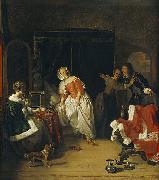China al por mayor de Marco de Oleo |
|||||||||||

|
|||||||||||
|
|
|
||||||||||||||
|
Gabrie Metsu
Gabriël Metsu (January 1629 - buried 24 October 1667) was a Dutch painter of history paintings, genre works and portraits. Metsu was the son of the Flemish painter Jacques Metsu (c.1588-1629), who lived most of his days at Leiden, and Jacomijntje Garniers, his third wife, whom he married in 1625. Jacomijntje was the widow of a painter with three children of her own. Two months after Gabriël's birth, his father died. According to Jacobus Houbraken, Metsu was taught by Gerard Dou, though his early works do not lend colour to this assertion. He was influenced by painters of Leiden such as Jan Steen, and later by Frans van Mieris the Elder. Metsu was registered among the first members of the painters' corporation at Leiden; and the books of the guild also tell us that he remained a member in 1649. In Leiden, it was alleged that Metsu left a brothel at six in the morning and took a prostitute to the Academy. In 1650 he ceased to subscribe, and works bearing his name and the date of 1653 support the belief that he had moved. Metsu was trained in Utrecht by Jan Baptist Weenix and Nicolaus Knepfer. The alley on Prinsengracht In Amsterdam Metsu lived in an alley on Prinsengracht, where he kept chickens. He got into an argument with a neighbor and moved to a house on the canal side, where a daily vegetable market was held. In 1658 he married Isabella de Wolff, whose father was a potter and mother a painter. The Speed Art Museum has a portrait of the couple. Pieter de Grebber, a religious painter from Haarlem, was her uncle. |
||||||||||||||
|
|
||||||||||||||
|
||||||||||||||
|
|
||||||||||||||
| Gabrie Metsu
Gabriël Metsu (January 1629 - buried 24 October 1667) was a Dutch painter of history paintings, genre works and portraits. Metsu was the son of the Flemish painter Jacques Metsu (c.1588-1629), who lived most of his days at Leiden, and Jacomijntje Garniers, his third wife, whom he married in 1625. Jacomijntje was the widow of a painter with three children of her own. Two months after Gabriël's birth, his father died. According to Jacobus Houbraken, Metsu was taught by Gerard Dou, though his early works do not lend colour to this assertion. He was influenced by painters of Leiden such as Jan Steen, and later by Frans van Mieris the Elder. Metsu was registered among the first members of the painters' corporation at Leiden; and the books of the guild also tell us that he remained a member in 1649. In Leiden, it was alleged that Metsu left a brothel at six in the morning and took a prostitute to the Academy. In 1650 he ceased to subscribe, and works bearing his name and the date of 1653 support the belief that he had moved. Metsu was trained in Utrecht by Jan Baptist Weenix and Nicolaus Knepfer. The alley on Prinsengracht In Amsterdam Metsu lived in an alley on Prinsengracht, where he kept chickens. He got into an argument with a neighbor and moved to a house on the canal side, where a daily vegetable market was held. In 1658 he married Isabella de Wolff, whose father was a potter and mother a painter. The Speed Art Museum has a portrait of the couple. Pieter de Grebber, a religious painter from Haarlem, was her uncle. Oil on panel, 66.7 x 59.4cm, National Gallery of Art, Washington Date c. 1661-1663 cyf |
||||||||||||||
|
Related Paintings to Gabrie Metsu :. |
||||||||||||||
|
|
||||||||||||||
|
|
||||||||||||||
|
CONTACTE EEUU |







